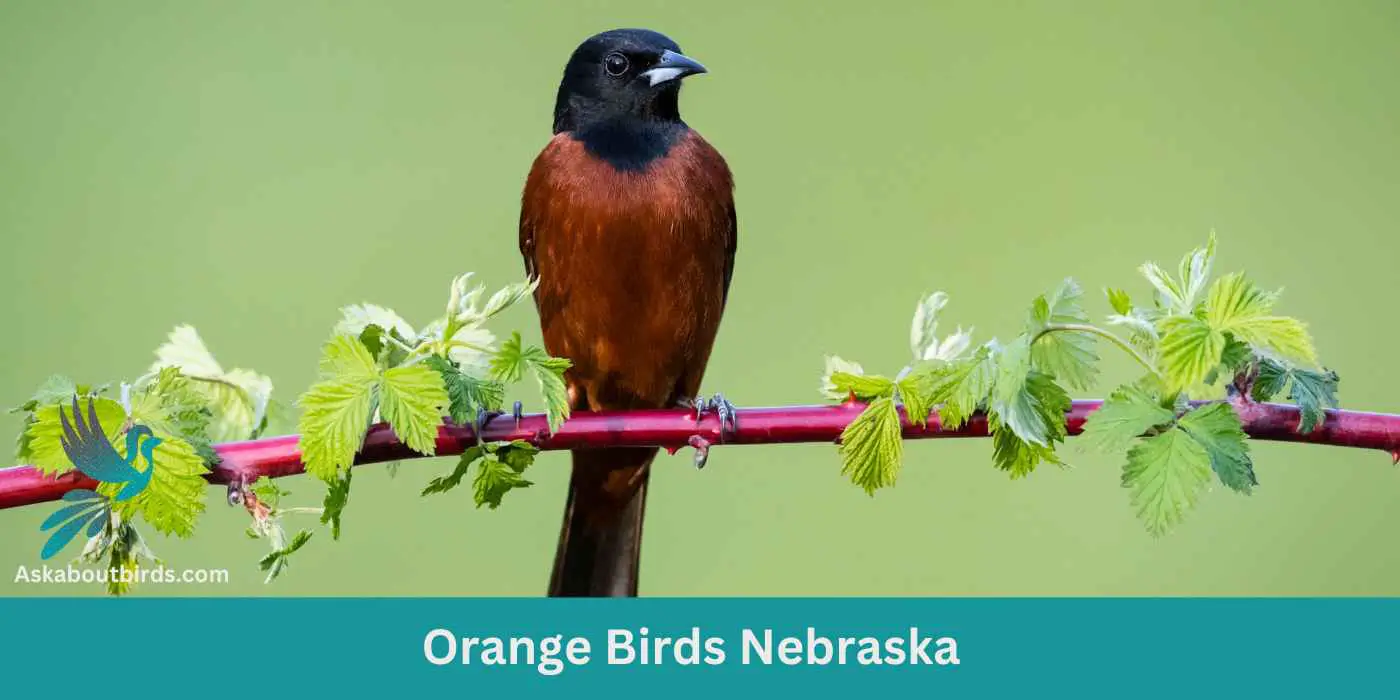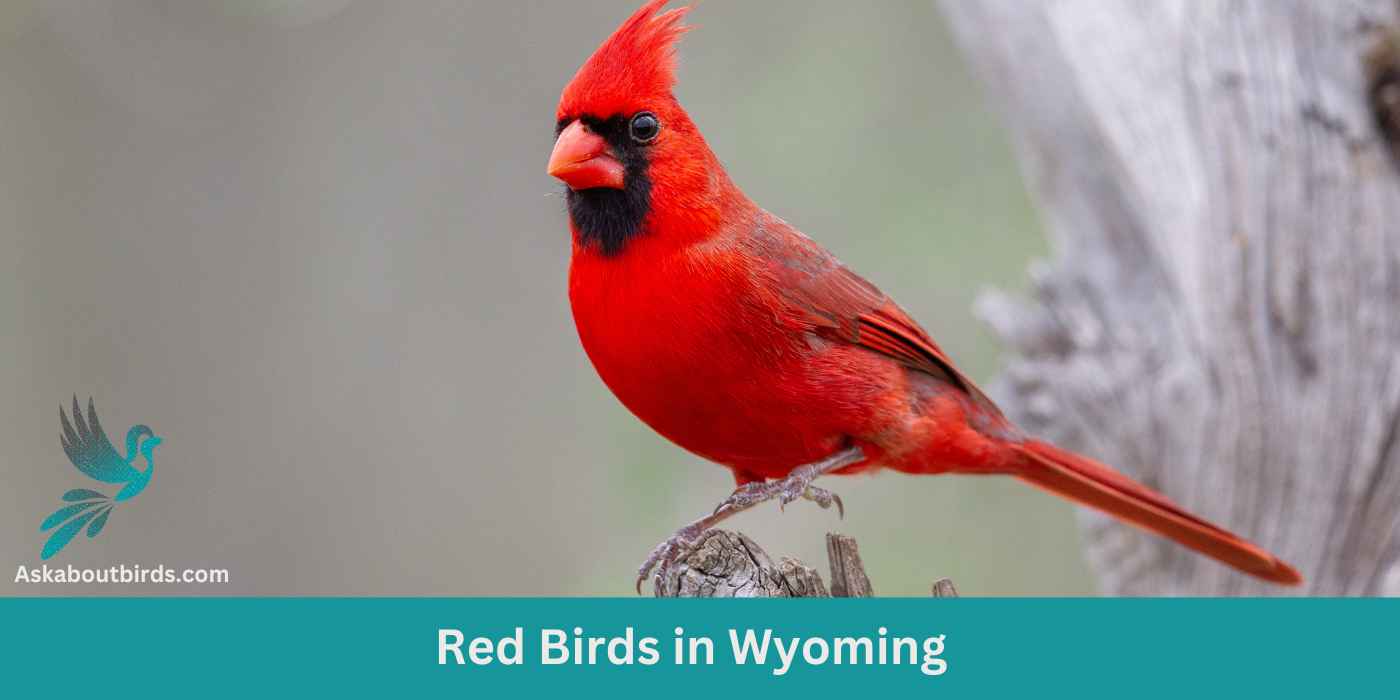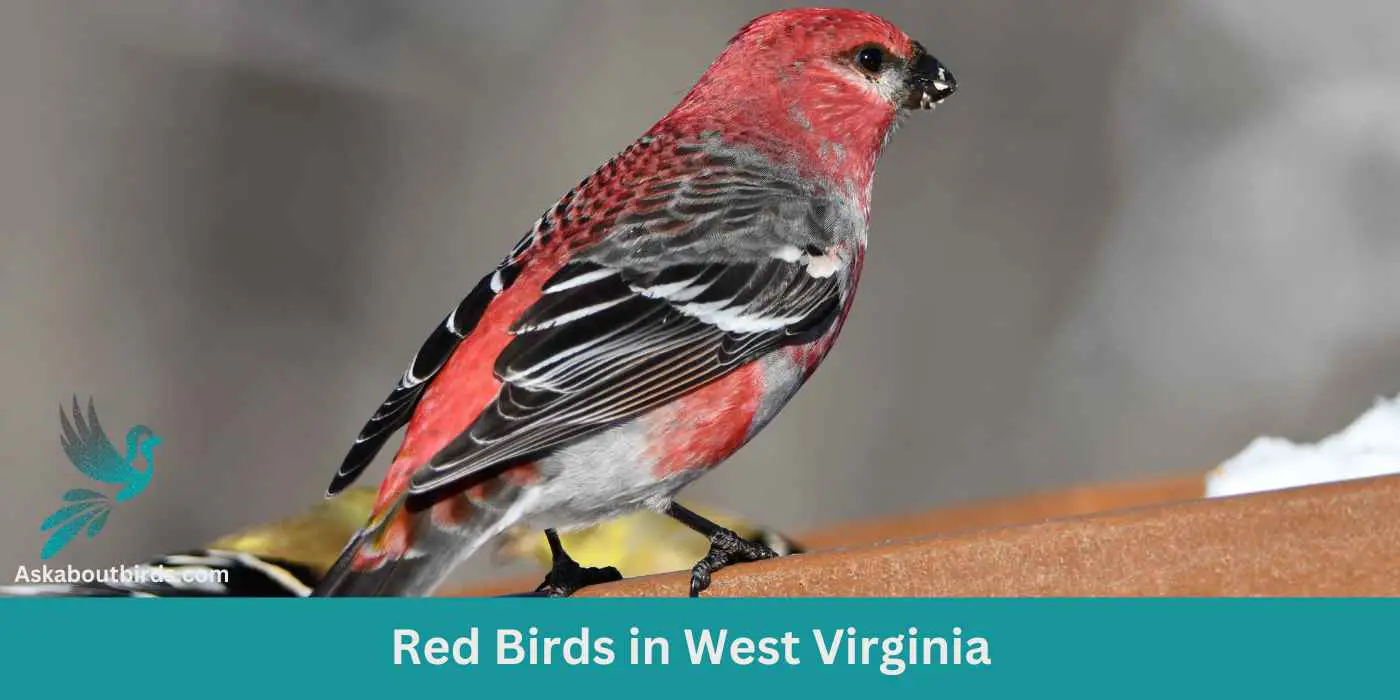Nebraska, with its sweeping plains and intricate ecosystems, is a haven for birdwatchers. Its diverse habitats are home to a myriad of bird species, and among them are some truly magnificent orange-colored avians. From the gentle flutters in the prairies to bold displays near the Platte, each bird adds a touch of brilliance to the state’s vast landscapes.
Orange Birds Found In Nebraska
Nebraska, situated at the convergence of multiple migratory routes, is a crossroads for avian life. The state’s varied terrains, ranging from the Sandhills in the north to the banks of the Missouri River in the east, create a patchwork of habitats perfect for a multitude of bird species.
The combination of native grasslands, wetlands, and wooded areas means that Nebraska provides both nesting grounds and migratory stops, resulting in a rich tapestry of bird diversity. Whether it’s the seasonal visitors or year-round residents, the state offers birdwatchers a plethora of species to marvel at, each with its unique song and story.
Baltimore Oriole


| Feature | Measurement |
|---|---|
| Scientific Name | Icterus galbula |
| Length | 6.7–8.7 in |
| Wingspan | 9.1–12.6 in |
| Weight | 22.3-42 g |
The Baltimore Oriole is a stunning bird, best known for its vibrant coloration and its rich, whistling song.
Appearance: The male Baltimore Oriole is notable for his bright orange and black plumage and black and white wing bars, a stark contrast to the more muted yellow-brown coloration of the female. Both sexes, however, have long pointed bills and white bars on their wings.
Diet: Baltimore Orioles have a diverse diet that includes insects, fruits, and nectar. Their preference for sweet juices and fruit pulp often brings them to backyard feeders offering oranges and jelly.
Reproduction: The female Baltimore Oriole is responsible for building the distinctive hanging nest, often woven together from fine materials like hair and grass. These nests are usually high in trees to avoid predators. The female lays 3-7 eggs, which are incubated for about two weeks.
Orchard Oriole
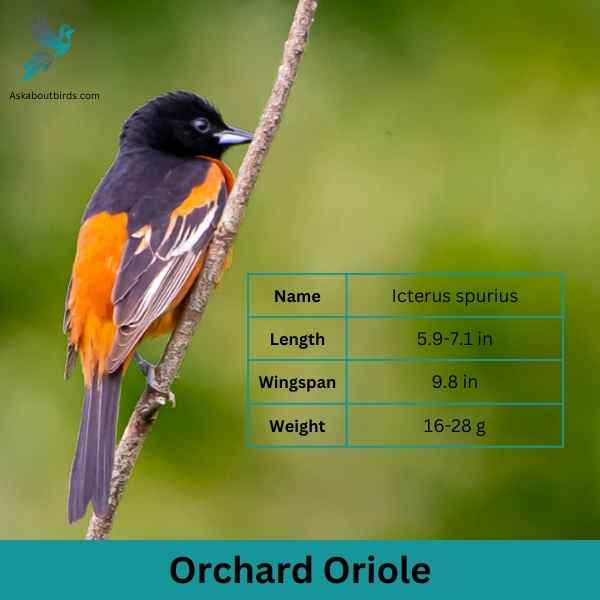
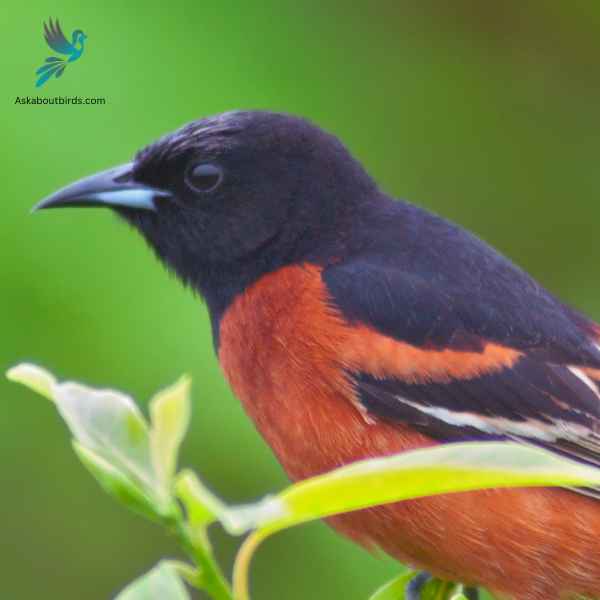
| Feature | Measurement |
|---|---|
| Scientific Name | Icterus spurius |
| Length | 5.9-7.1 in |
| Wingspan | 9.8 in |
| Weight | 16-28 g |
The Orchard Oriole is a small songbird noted for its distinctive coloration and melodic song.
Appearance: Male Orchard Orioles are a striking sight with their dark chestnut body and black head and black and white wings, while females and immature males are olive-green and feature a yellowish underpart. The species is often recognized by its slender body and pointed bill.
Diet: The diet of the Orchard Oriole consists primarily of insects, fruits, and nectar. They are adept at catching insects mid-air and are also known to sip nectar from flowers, aiding in pollination. When fruits are in season, they make up a substantial portion of the bird’s diet.
Reproduction: Orchard Orioles often nest in open woodlands and orchards, hence their name. The female is responsible for building the nest, typically choosing a location in a tree or shrub. The female lays a clutch of 4 to 6 eggs, which she incubates for about two weeks.
Scarlet Tanager


| Feature | Measurement |
|---|---|
| Scientific Name | Piranga olivacea |
| Length | 6.3 to 7.5 in |
| Wingspan | 9.8 to 11.8 in |
| Weight | 23.5 to 38 g |
The Scarlet Tanager is a strikingly colorful bird known for its brilliant plumage and distinctive song.
Appearance: Male Scarlet Tanagers are notable for their vibrant scarlet bodies contrasted with black wings and tail, making them one of the most intensely colored birds. Females and juveniles, on the other hand, have a subdued olive-yellow body color with darker wings and tail.
Diet: The diet of the Scarlet Tanager is largely made up of insects, including beetles, cicadas, aphids, and others. They are adept flycatchers, seizing insects in mid-air or picking them off foliage. They also consume fruits and berries, especially during migration and in their winter habitats.
Reproduction: The female Scarlet Tanager builds a cup-shaped nest using twigs, rootlets, and grass, typically well-hidden in the dense foliage of trees. She lays 3 to 5 eggs and incubates them for about two weeks.
American Redstart


| Feature | Measurement |
|---|---|
| Scientific Name | Setophaga ruticilla |
| Length | 4.3 to 5.5 in |
| Wingspan | 6.3 to 9.1 in |
| Weight | 8.6 g |
The American Redstart is a lively warbler known for its vivid colors and active hunting style, often seen flitting about, fanning its tail to startle and catch insects.
Appearance: Adult male American Redstarts boast striking black plumage with bright orange patches on the sides, wings, and tail. Females and immature males have grayish-olive upperparts with yellow patches in the same areas where the males display orange.
Diet: American Redstarts are primarily insectivores. They actively forage for flying insects, as well as caterpillars and spiders, often using their colorful tails to startle prey and make them easier to catch.
Reproduction: The female American Redstart builds a cup-shaped nest in the fork of a tree branch. Typically, she lays a clutch of 3 to 5 eggs. The female takes on the primary responsibility of incubating the eggs, while both parents participate in feeding the fledglings after they hatch.
Eastern Towhee

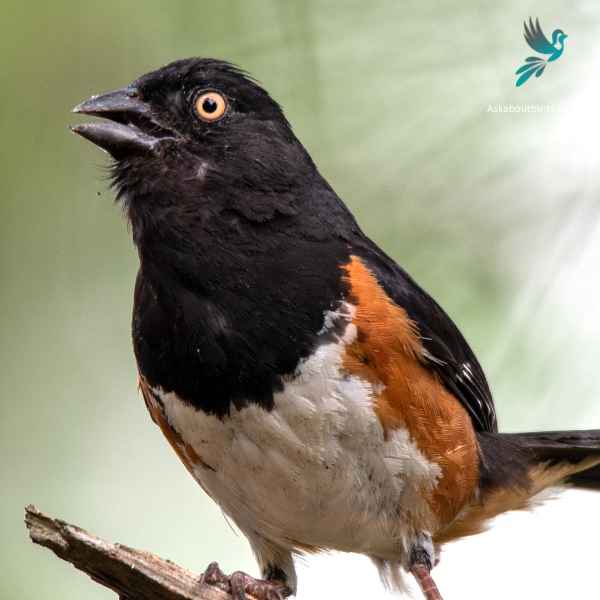
| Feature | Measurement |
|---|---|
| Scientific Name | Pipilo erythrophthalmus |
| Length | 6.8 to 9.1 in |
| Wingspan | 7.9–11.8 in |
| Weight | 32 to 53 g |
The Eastern Towhee is a distinctive songbird known for its unique calls and eye-catching coloration.
Appearance: Male Eastern Towhees are characterized by a striking combination of a black head, back and tail, contrasting with a white belly and rufous flanks. Females sport similar patterns but instead of black, they have a rich brown color. Both genders have red eyes, lending a special charm to their overall appearance.
Diet: Eastern Towhees primarily feed on a variety of insects, seeds, and berries. Their diet is quite diverse, taking advantage of seasonal offerings, which includes beetles, caterpillars, spiders, acorns, grass seeds, and various fruits and berries.
Reproduction: Eastern Towhees build their nests on or near the ground, often in a shrub or a small tree. The female lays around 3-5 eggs and takes the primary role in incubating them over about 12-13 days.
Spotted Towhee

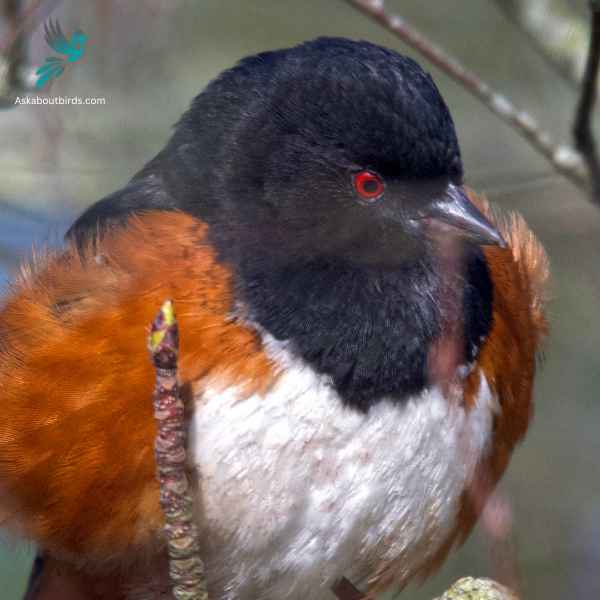
| Feature | Measurement |
|---|---|
| Scientific Name | Pipilo maculatus |
| Length | 6.7-8.3 in |
| Wingspan | 11.0 in |
| Weight | 33 g |
The Spotted Towhee is a distinctive songbird commonly found in the shrubby undergrowth and thickets of the western parts of North America. Its song, a series of melodious chirps, often punctuates the early morning air.
Appearance: Male Spotted Towhees showcase a coal-black head, throat, and upper body contrasted with rufous sides and a white belly. Their wings and back are dark but adorned with white spots, hence their name. Females have a similar pattern but are more brownish than black.
Diet: Spotted Towhees primarily feed on a mixture of insects and seeds. They often forage on the ground, scratching through leaf litter to uncover beetles, ants, and other insects, as well as various seeds and berries.
Reproduction: Spotted Towhees usually nest on the ground, concealed by dense vegetation or sometimes in low shrubs. The female builds the nest and lays a clutch of 3 to 5 eggs. She incubates the eggs, while the male stands guard and both parents partake in feeding the fledglings after hatching.
Black-headed Grosbeak

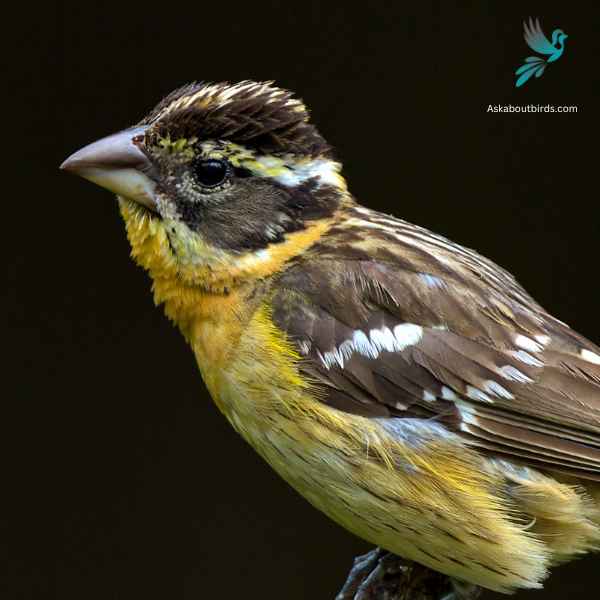
| Feature | Measurement |
|---|---|
| Scientific Name | Pheucticus melanocephalus |
| Length | 7.1–7.5 in |
| Wingspan | 12.6 in |
| Weight | 34–48 g |
The Black-headed Grosbeak is a vibrant songbird known for its melodious song, often confused with that of the American Robin but more rich and varied.
Appearance: Males are recognizable by their orange chest, black head, and black and white wings. Females, on the other hand, have a streaked brown appearance, resembling large sparrows but with hints of orange on their sides and flanks.
Diet: Black-headed Grosbeaks primarily feed on insects, seeds, and fruits. They are especially fond of beetles and caterpillars, and they’re one of the few birds that can eat monarch butterflies without suffering from the toxins.
Reproduction: They often nest in deciduous trees or shrubs. The nest is a loose, cup-like structure made from twigs and grasses. The female usually lays 3 to 4 eggs, which she incubates. Both parents share the responsibility of feeding the chicks.
Blackburnian Warbler
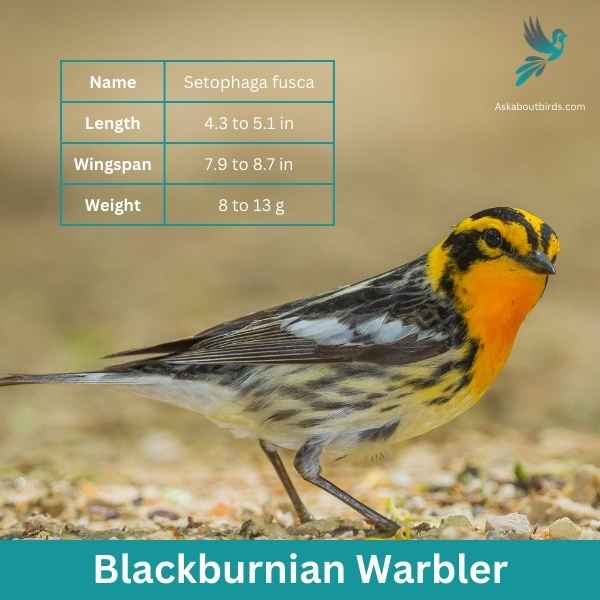

| Feature | Measurement |
|---|---|
| Scientific Name | Setophaga fusca |
| Length | 4.3 to 5.1 in |
| Wingspan | 7.9 to 8.7 in |
| Weight | 8 to 13 g |
The Blackburnian Warbler is a strikingly colored songbird that captivates observers with its vivid plumage, especially during the breeding season. Often found flitting high in the treetops of North American forests, its melodious song is as enchanting as its appearance.
Appearance: Male Blackburnian Warblers are distinguished by their fiery-orange throats, contrasting sharply with a black face, crown, and streaked back. They also have white underparts with black streaks on the sides. Females have a more muted coloration, with a yellowish or pale orange throat and less pronounced streaking.
Diet: Blackburnian Warblers primarily feed on insects and spiders. They are adept at foraging in the canopy, where they glean insects from the surface of leaves and branches or catch them mid-air in quick, agile flights.
Reproduction: Blackburnian Warblers build their nests high up in coniferous trees, often on horizontal branches. The nest is a neat cup made of twigs, grass, and moss, lined with softer materials like hair or feathers. The female lays a clutch of 4 to 5 eggs and takes the lead in incubation.
Northern Flicker

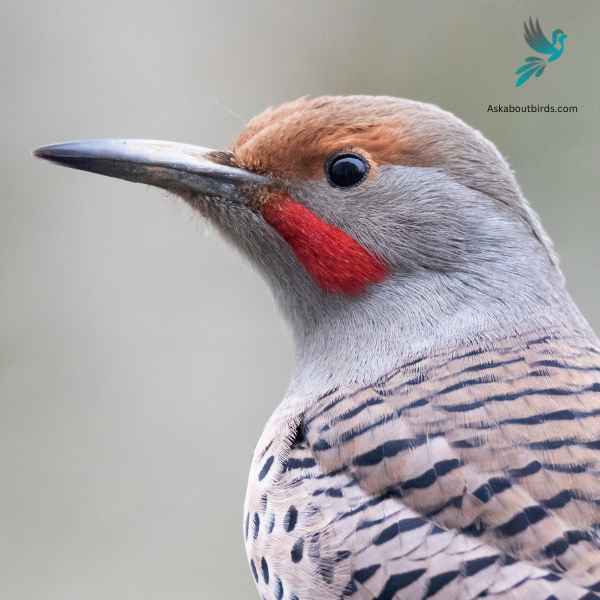
| Feature | Measurement |
|---|---|
| Scientific Name | Colaptes auratus |
| Length | 11–12 in |
| Wingspan | 17–20 in |
| Weight | 3.9–5.6 oz |
The Northern Flicker is a medium-sized woodpecker, recognized by its unique patterns and coloring, often found drumming on trees or foraging on the ground across North America.
Appearance: The Northern Flicker stands out with its grayish brown body, black-scalloped plumage, and a black bib. Males sport a distinctive black or red mustache stripe. Depending on the subspecies, the underwing and undertail feathers can be bright yellow or red, flashing vividly during flight.
Diet: While most woodpeckers are tree-bark foragers, the Northern Flicker prefers hunting on the ground. Its primary diet consists of ants and beetles, supplemented occasionally by fruits, berries, seeds, and other small insects.
Reproduction: Northern Flickers are cavity nesters, preferring to excavate their nesting hole in dead or diseased tree trunks. The interior of the nest is lined with wood chips.
Barn Swallow

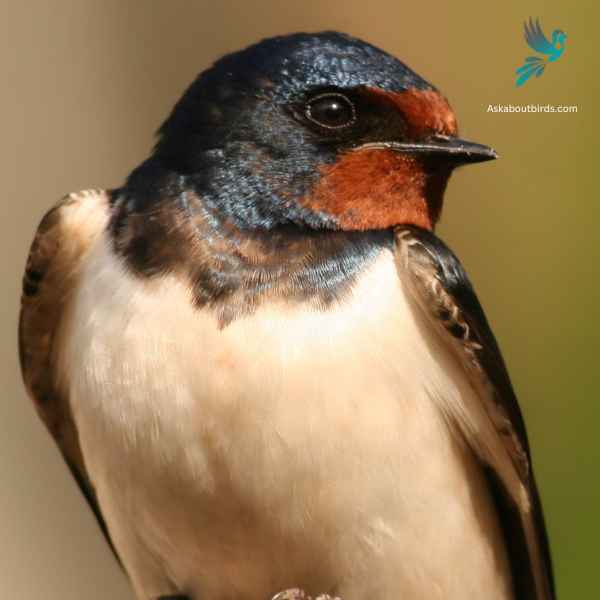
| Feature | Measurement |
|---|---|
| Scientific Name | Hirundo rustica |
| Length | 6.5–7.5 in |
| Wingspan | 12.5–13.5 in |
| Weight | 16–22 g |
The Barn Swallow is a sleek, agile bird renowned for its graceful flight patterns and iconic forked tail, often seen darting over fields and water bodies in search of flying insects.
Appearance: Barn Swallows have deep blue, almost iridescent, upperparts and a rufous to tawny underbelly. Their distinctively forked tail and long wings give them a streamlined look. Both males and females have a similar appearance, though males often exhibit slightly brighter colors and a deeper fork in the tail.
Diet: Barn Swallows feed primarily on flying insects, which they catch in mid-air during their agile and acrobatic flights. Their diet includes flies, beetles, moths, and other small flying insects.
Reproduction: Barn Swallows are known for building their mud nests on man-made structures, particularly barns, bridges, and eaves. The nest is cup-shaped and made from mud pellets, often lined with feathers. The female lays a clutch of 4 to 6 eggs.
American Robins


| Feature | Measurement |
|---|---|
| Scientific Name | Leptotila plumbeicep |
| Length | 10.6-11.8 in |
| Wingspan | — |
| Weight | 160-200 g |
The American Robin is a widely recognized bird species known for its melodious song and early bird tendencies.
Appearance: American Robins are medium-sized birds with a distinctive appearance. Both males and females sport a gray to brown back and a warm red to orange breast and belly and gray wings. They also have a characteristic white eye-ring and a black head, but males are usually darker than females.
Diet: American Robins have a diverse diet that changes depending on the season. In summer, they feed heavily on earthworms, beetles, and other invertebrates, which they catch on the ground. During winter, they mostly eat fruits and berries.
Reproduction: American Robins usually build their nests in trees or shrubs, but they are also known to nest on human-made structures. The female lays a clutch of about 3 to 5 eggs, which she incubates for about 12 to 14 days.
Red-breasted Nuthatch

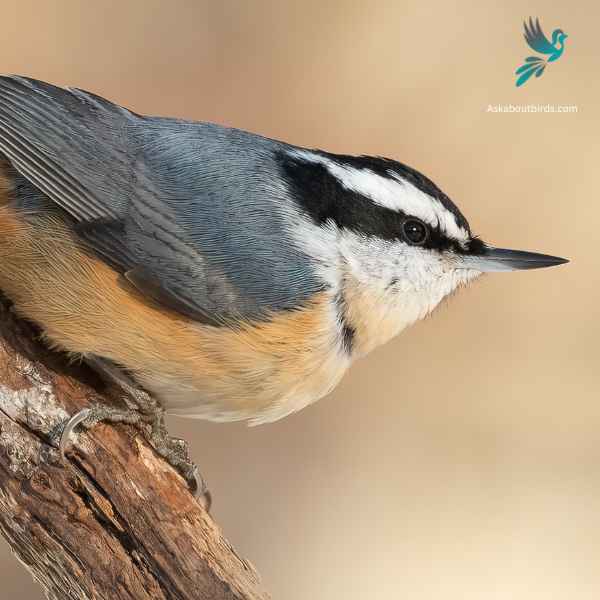
| Feature | Measurement |
|---|---|
| Scientific Name | Sitta canadensis |
| Length | 4.3–4.7 in |
| Wingspan | 8.3 in |
| Weight | 0.3–0.5 oz |
The Red-breasted Nuthatch is a small, agile songbird, known for its ability to move headfirst down tree trunks while searching for food.
Appearance: This bird boasts a slate-blue back and a pale rust-red underside. A prominent black stripe runs through the eye and is bordered above by a white eyebrow. Their sharp, pointed bill is characteristic of the species.
Diet: Red-breasted Nuthatches primarily feed on insects and seeds, especially those from coniferous trees. They have a fondness for large seeds, which they wedge into bark crevices to hack open with their bills.
Reproduction: These birds construct nests in natural tree cavities or abandoned woodpecker holes, often lining the entrance with resin. This is thought to deter predators or competitors from entering. The female typically lays a clutch of 5 to 6 eggs, and both parents partake in feeding the chicks once they hatch.
Summer Tanager


| Feature | Measurement |
|---|---|
| Scientific Name | Piranga rubra |
| Length | 6.7 in |
| Wingspan | 28 to 30 cm |
| Weight | 29 g |
The Summer Tanager is a medium-sized songbird admired for its radiant plumage and melodious song.
Appearance: Male Summer Tanagers are an impressive bright red, while females and juveniles present a softer, yellow-orange color. Both genders have a large, slightly hooked bill and relatively short tail.
Diet: Summer Tanagers primarily feed on insects, including bees and wasps, which they catch in flight or pick off vegetation. They are also known to eat fruits and berries, making them helpful in controlling pest populations and seed dispersal.
Reproduction: The female Summer Tanager builds a loose, shallow cup-shaped nest out of twigs and grass, usually hidden in the foliage of trees. The female typically lays 3-5 eggs, which she will incubate for about two weeks.
Western Tanager

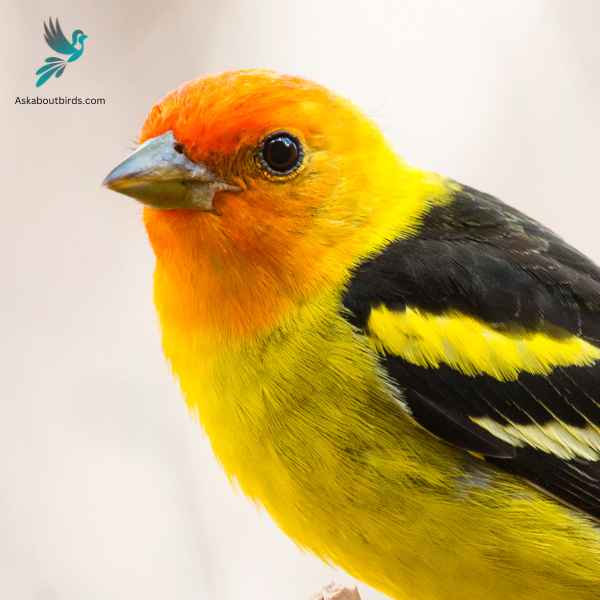
| Feature | Measurement |
|---|---|
| Scientific Name | Piranga ludoviciana |
| Length | 6.3-7.5 in |
| Wingspan | 11.5 in |
| Weight | 24-36 g |
The Western Tanager is a vibrant songbird that graces the forests and woodlands of the western regions of North America, enchanting observers with its colorful plumage and melodious song.
Appearance: The male Western Tanager is renowned for its bright yellow body contrasted with a striking red head and black wings and tail. The females are more subdued in hue, primarily being yellow with grayish wings and back, and lacking the brilliant red head of the males.
Diet: Western Tanagers primarily feed on insects, especially when breeding, but they also incorporate a significant amount of fruits and berries into their diet, especially during migration and winter.
Reproduction: Western Tanagers build their nests high in coniferous trees, often well concealed from potential predators. The female usually lays a clutch of 3 to 5 eggs and takes the primary role in incubation, while both parents are involved in feeding the chicks after they hatch.
Where to Spot Nebraska’s Orange Birds
Nebraska’s heartland pulse is marked not just by its cornfields, but by the symphony of bird calls. For those seeking the vibrant hues of orange-feathered avians, here are the top locales you shouldn’t miss:
- Rowe Sanctuary (Gibbon): Nestled along the Platte River, this sanctuary is renowned for its Sandhill Cranes but also hosts a diverse range of other birds. Its wetlands and prairies are a haven for birdwatchers, especially during migrations.
- Fontenelle Forest (Bellevue): This ancient woodland is a haven for many bird species. Its mix of forests and wetlands by the Missouri River makes it a top spot to catch a glimpse of both waterfowl and forest birds.
- Crescent Lake National Wildlife Refuge (Ellsworth): Spanning over 45,000 acres, the refuge’s dunes, marshes, and lakes attract an assortment of bird species. It’s a serene backdrop for those hoping to spot waterfowl and prairie birds alike.
- Indian Cave State Park (Shubert): With rugged terrains and dense hardwood forests, this park is a birdwatcher’s dream, especially during the fall migration. The park’s varied habitats make it a hotspot for diverse bird sightings.
- Niobrara State Park (Niobrara): Where the Niobrara meets the Missouri, this confluence creates an environment rich in bird life. From grassland birds to those favoring the dense tree canopies, it’s a symphony of chirps and calls year-round.
| State’s Orange Birds | Best Spots for Orange Birds |
|---|---|
| South Dakota’s Orange Birds | Custer State Park, Badlands National Park, Bear Butte State Park |
| Iowa’s Orange Birds | Neal Smith National Wildlife Refuge, Ledges State Park, Big Creek State Park |
| Missouri’s Orange Birds | Mark Twain National Forest, Mingo National Wildlife Refuge, Shaw Nature Reserve |
| Kansas’s Orange Birds | Cheyenne Bottoms, Quivira National Wildlife Refuge, Tallgrass Prairie National Preserve |
| Colorado’s Orange Birds | Rocky Mountain National Park, Maroon Bells, Garden of the Gods |
| Wyoming’s Orange Birds | Yellowstone National Park, Grand Teton National Park, Seedskadee National Wildlife Refuge |
FAQs on Orange Bird Species Found in Nebraska
What orange-bellied birds are commonly seen in Nebraska’s backyards?
In Nebraska, one of the notable birds with an orange belly is the Northern Cardinal. The males boast bright red heads and a rusty orange body, making them a favorite among bird watchers. Another bird that can be occasionally spotted is the Eastern Bluebird, characterized by its deep blue back and bright orange plumage on the belly.
Which birds with white wing bars often visit bird feeders in Eastern Nebraska?
The most common backyard birds would include the Red-breasted Nuthatch, known for its distinct white wing bars and cute bird appearance. Another frequent visitor is the Black-capped Chickadee, which showcases prominent white wings paired with a defining black cap.
How can residents attract more yellow birds to their backyard bird feeders?
To attract yellow birds like Yellow Warblers and the Western Meadowlark, Nebraska residents can stock their bird feeders with sunflower seeds, especially black oil sunflower seeds. These seeds are particularly favored by yellow birds and other backyard birds.
What is a rust colored bird in Nebraska?
In Nebraska, the American Robin is a commonly spotted bird with a rust-colored chest. While they are often associated with early spring, these birds can be seen throughout much of the year, foraging on the ground in lawns, parks, and woodland areas.
What bird has bright orange on it?
The Baltimore Oriole is a bird that features bright orange plumage, combined with black and white. These birds are often seen in the eastern and central parts of North America and are known for their vibrant appearance and melodious songs.
How long do Orioles stay in Nebraska?
Orioles, particularly the Baltimore and Bullock’s Orioles, typically arrive in Nebraska in late April to early May and stay throughout the summer breeding season. By late August to early September, they begin their migration southward. Thus, they stay in Nebraska for approximately 4 to 5 months, depending on various factors like weather conditions and food availability.
What small birds are orange?
In North America, one of the smaller birds with an orange hue is the Rufous Hummingbird. This tiny bird displays a brilliant orange or rufous color on its flanks, tail, and sometimes its throat. While they’re more common in the western parts of the continent, their migratory paths can sometimes lead them to various regions.
Does the Red-headed Woodpecker migrate to Central and South America?
The Red-headed Woodpecker, known for its striking entirely red head, is primarily found in North America. While some woodpecker species do migrate to Central and South America, the Red-headed Woodpecker generally does not venture that far south.

